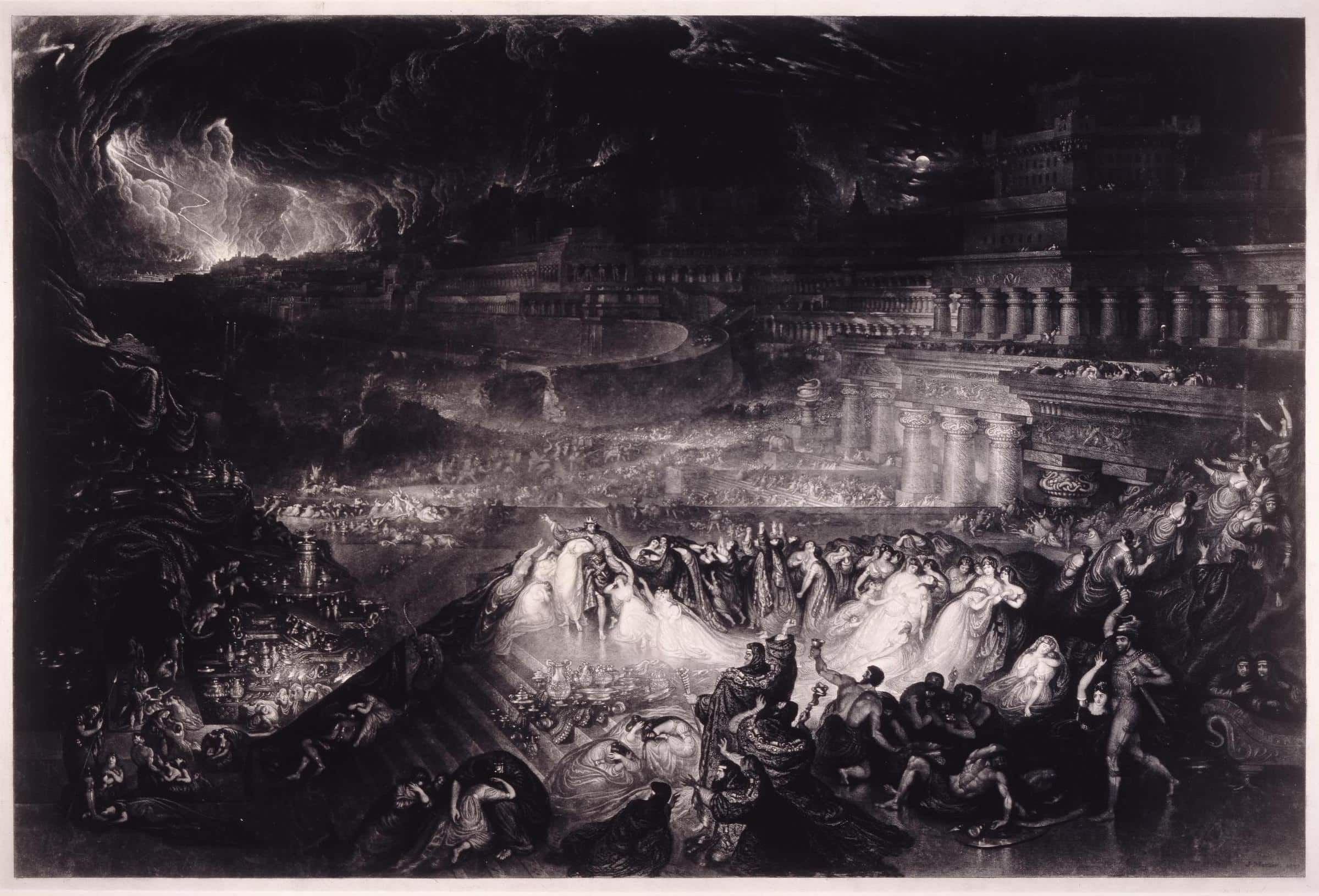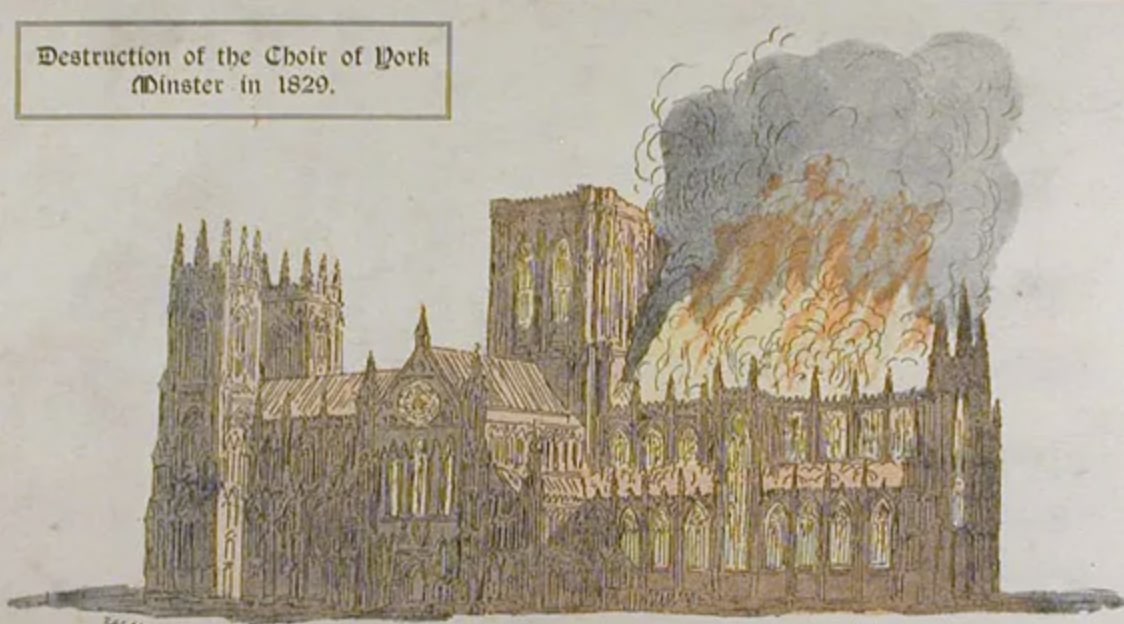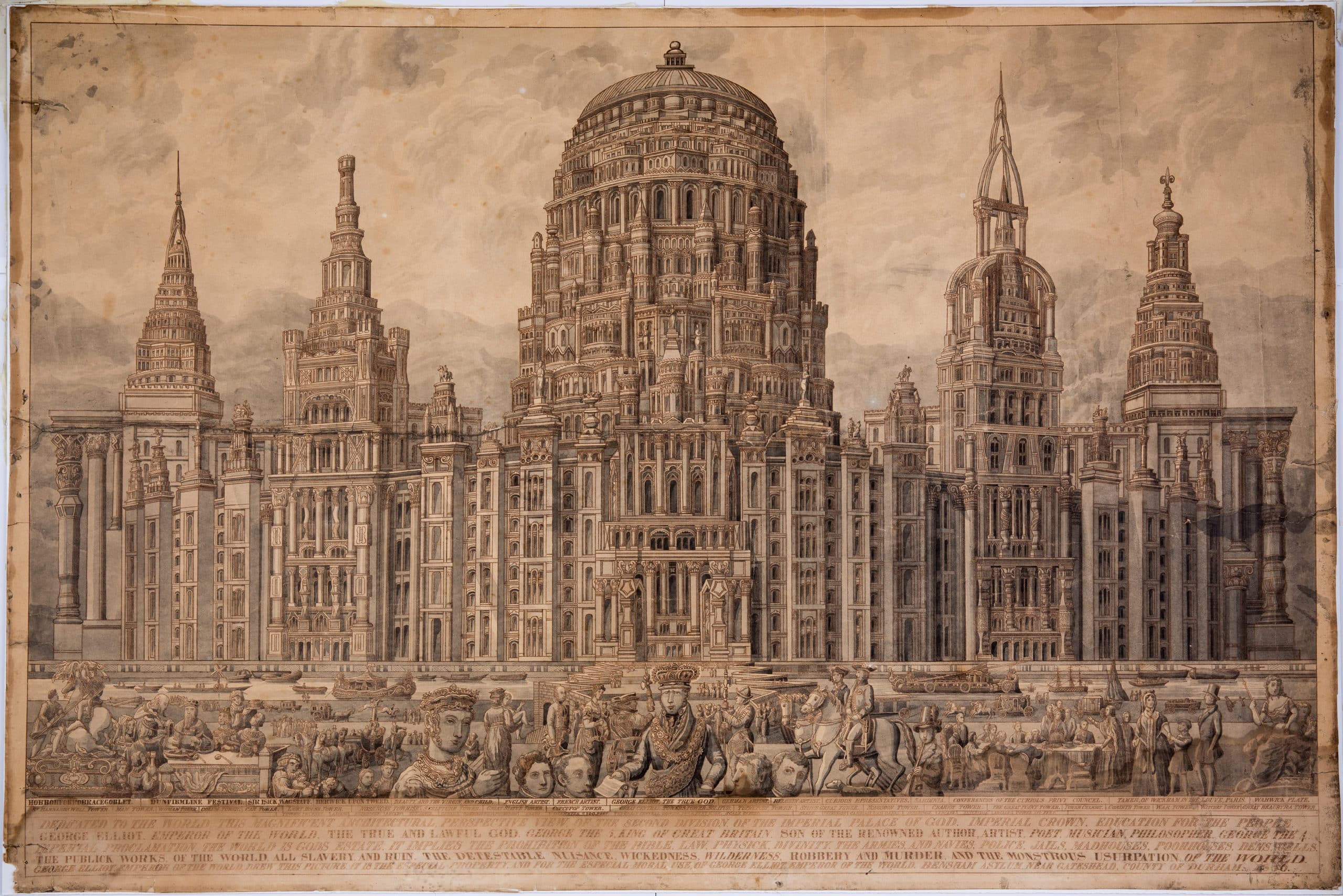Entering the Imperial Palace

‘What a subject for John Martin!’ exclaimed a passer-by, as the hungry flames flickered up York Minster. Maybe they had in mind his apocalyptic painting The Fall of Nineveh, exhibited that same year at the Western Exchange on Old Bond Street and reproduced widely as a mezzotint print.
Unbeknown to her, a few hours earlier, the fire had been started by Jonathan Martin, the artist’s younger brother. If the Martins’ parents had known the lives their children would lead, they might have considered naming John and Jonathan less awkwardly, but their father being a journeyman tanner may have little expected their extraordinary legacies.
Jonathan was brought up for the most part not by his parents but by his aunt, a staunch Protestant whose vivid tales of hellfire and damnation must have made a forceful impact on his young imagination. Despite having eleven siblings he lived in solitude, prone to midnight solitary excursions to Hexham’s mines, perhaps internalising his thoughts due to his ankyloglossia (a shortened skin between his tongue and his mouth). His closest family member and confidant was his sister until he witnessed her murder at the hands of a neighbour, the first of countless traumatic experiences preying upon his imagination and mental health, which he later expressed in words, art, and arson.

It’s an impossible task to translate such a strange and eventful life as Jonathan’s into a text of this length. The most I can do is draw a faint impression that may help you form your own interpretation. A drawing is made of lines focused on the communication of an idea, but at its base, mark-making is a process of enclosing absences, and it is those absences that are most fertile.
The Imperial Palace of God, attributed to a George Elliot, has no end of absences. There is a lot of volume and stuff within it to consider, perhaps too much, you could even say it’s deliberately obtuse and confused. Evidently, the Palace is not a real place, so what kind of place is it? Most of Drawing Matter’s archive is indexed, understood, and anchored to something of substance — a built project, theoretical development, or an individual’s creative arc —, but this drawing isn’t. It’s untethered. While it can be found and located in physical space and the catalogue, its history, meaning, and purpose cannot.

So who was George Elliot? What is the fantastical Imperial Palace? And what of the staccato block-capital proclamations along the bottom that read GEORGE ELLIOT. EMPEROR OF THE WORLD. THE TRUE AND LAWFUL GOD?
Dr Henry Noltie once told me of his ‘throwaway suggestion’ that the portrait of GEORGE ELLIOT, THE TRUE AND LAWFUL GOD looked somewhat similar to Jonathan Martin, the arsonist. It’s true: Jonathan’s self-portrait within his drawing The Lambton Worm and Self Portrait in the Bethlem Museum of the Mind shows the same pursed smile, knobbly nose, cleft chin, and generous sideburns. But Jonathan died in 1838, eighteen years before the 1856 date indicated on the drawing. Noltie found a coincidence. But for a drawing like this, coincidence could be a good place to start.
A key source into any excavation of Jonathan’s story is his autobiography, Of The Life of Jonathan Martin, of Darlington, Tanner, published three times between 1825 and 1828 and hawked across Northern England by a donkey for a few pence a copy, dressed in coat and boats made of sealskin. You might sigh in relief at the prospect of a detailed primary source if it were not for the fact that Jonathan is a perilously unreliable narrator. Truth becomes entangled with romantic prophetic visions and political foretelling of the future.
Some facts, however, are undeniable. Aged twenty-two, he moved to London to find work on Indian continent trading ships, but on a visit to the Monument to the Great Fire of London, he was pressganged. Six misadventurous years in the Navy followed, then more sailing work on trade and merchant ships, crisscrossing from Cadiz to Cairo, capturing Spaniards and warring Danes. His dramatic tales pile up: he prevented an explosion by extinguishing burning pistol wadding that was smouldering next to five hundred barrels of gunpowder, ignited after the gunner’s yeoman shot his brains across the ship’s stores; he was knocked out and rescued from drowning more than once; he severely damaged his skull in a fall, and scalped a sailor by grabbing his ponytail in another; he once deserted the Navy, got drunk, lost his trousers, then walked in a confused circle before accidentally returning to the ship, and apologetically climbing back on board.
It was while partaking in blockades of Cadiz, narrowly avoiding death from shore batteries, that he, unsurprisingly, decided to return to England, where he became a Wesleyan Methodist on a proselytising mission. Years later at his trial for arson, a Chelsea Pensioner who had been one of his ship companions said, ‘he was a very good sailor, but had fits of melancholy […] would talk of dying and a future state’. In the third edition of his autobiography, after acknowledging the popularity of his older brother John’s artwork, he described himself as having ‘…the gift of prophecy, which is the best of all, for I feel that God is with me’.
Between his 1829 trial and death in 1838, Jonathan resided at St. Mary Bethlehem Hospital, or Bedlam, in a white-washed room with a table, a chair, and grated window so high up it offered a view of the sky only. In 1833, a magazine reported him as being ‘perfectly satisfied’ in the room, wanting nothing other than his supply of ‘Indian ink and Brookman’s black-lead pencils’. His older brother’s art career was booming. John’s engravings and paintings of biblical spectacle were touring and sold across a burgeoning cultural marketplace. Jonathan was giving away his drawings and writings to visiting strangers.
Drawing was a key means of communication for Jonathan, arguably more so than it was for his brother for whom it was a career but not a singular mode of communication. While John translated the stories of others into drama and awe as prophetic warnings, Jonathan was using drawing to translate stories that had never been told: from mind to paper, they were sincere messages from God concealed within his vivid dreams. Jonathan’s dreams repeatedly summoned the ‘son of Napoleon’, an imagined future conqueror of England. The son starred in a recurring fantasy wherein his armies rose from the North Sea, initiated a war, then headed south to burn London. Jonathan believed he would one day meet the young Emperor, working with him to ensure the nation worshipped God in the correct Wesleyian way.
One of his drawings, made around 1830 from his Bethlam cell, was London’s Overthrow. It carries a remarkable likeness to his brother’s fall of Nineveh, with rows of columns transformed into industrial architecture. It shows an awareness of his celebrated brother’s work, adopting his aesthetic to propel his own ideas.
So, what of the fantastical Imperial Palace itself? I suspect it is a drawing by Jonathan Martin, as Noltie half-wondered. The marks carry his signature, and it is rendered in Indian ink as supplied by Bedlam staff. I see within the palace’s Solomonic columns, openwork spires, turreted towers, and pyramid crowns a potential assemblage of the Egyptian, Sicilian, and other architectures he might have encountered over his sailing years. It is also possible to see in the Imperial Palace elements of the distant city of Gibeon as imagined in his brother’s breakthrough painting Joshua Commanding the Sun to Stand Still upon Gibeon. John would take sketches of the early composition to show his younger brother shortly before he was first committed to an asylum (after threatening to shoot the Bishop of Oxford). That first asylum was in Norton, but he was soon moved to one in Sherrif Hill, Gateshead – about a mile from the Bensham Asylum written into the footer of The Imperial Palace of God.
George Elliot could be a pseudonym for Jonathan, as the purported facial likeness suggests. But he could also be a prophetic future character based on Admiral George Elliot, born in 1813 to the Whig politician Admiral George Elliot, who served alongside Jonathan in the Siege of Cadiz when his life changed trajectory.
All drawings are two-dimensional. Whether a scrawled attempt to make sense of a passing thought or a considered geometric draft, a drawing is flat. They are an idea of an idea. And it’s arguably impossible to convey intended meaning from author to viewer. When committing a vision to paper (for an architect, artist, or writer) there is an element of prophecy, a commitment to some hope of others seeing your vision. In trying to receive that same image, the reader also employs a prophetic gaze, locating it within a real and imagined past and future, and extracting that which is nascent.
So drawing is doomed to never truthfully represent or be accurately read. But what is lost, what was never there, and what is assumed in a process that translates times over from internal to representation and then back to internal? Maybe The Imperial Palace of God does not represent any truth other than an amalgamation of Jonathan Martin’s memories, dreams, and visions. Maybe in the search to determine who the artist was, it is found that neither George Elliot nor Jonathan Martin truly existed. They, like the Palace, are both shown to be fictions.
As viewers, we should ask ourselves how we can frame our understanding of a drawing so utterly composed of absence and prophecy. Seeing Jonathan’s pen so inextricably linked to his fantasies, how can we discern where the eye ends and the mind begins? When attempting to find sense in a drawing as deliberately obtuse as The Imperial Palace Of God, are we not, in fact, drawing our own prophecies, which will be read, reread and misread by those to come? The Imperial Palace of God shows us that it is the absences that speak most truthfully.
Will Jennings is an artist, writer, curator, and educator based in London. His online publication, recessed.space, can be found here.
This text was entered into the General Archive category for the 2021 Drawing Matter Writing Prize.
